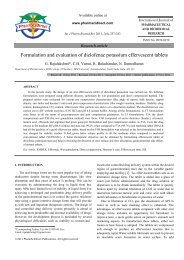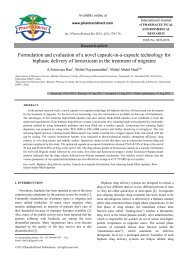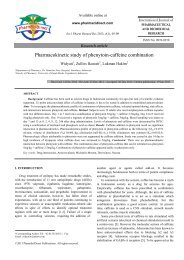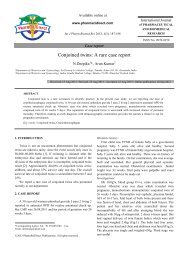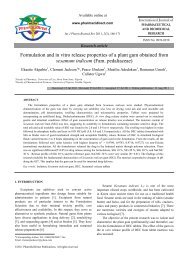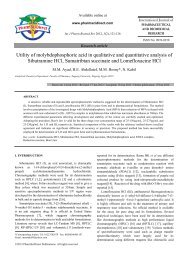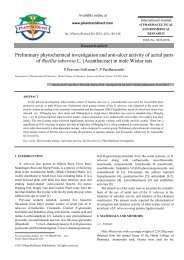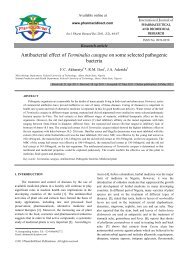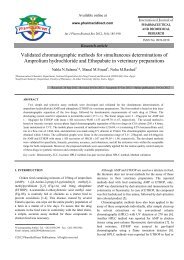Effect of ghrelin hormone on ovary histology in ... - PharmSciDirect
Effect of ghrelin hormone on ovary histology in ... - PharmSciDirect
Effect of ghrelin hormone on ovary histology in ... - PharmSciDirect
You also want an ePaper? Increase the reach of your titles
YUMPU automatically turns print PDFs into web optimized ePapers that Google loves.
Available <strong>on</strong>l<strong>in</strong>e at<br />
www.pharmscidirect.com<br />
Int J Pharm Biomed Res 2012, 3(3), 141-146<br />
Research article<br />
Internati<strong>on</strong>al Journal <str<strong>on</strong>g>of</str<strong>on</strong>g><br />
PHARMACEUTICAL<br />
AND BIOMEDICAL<br />
RESEARCH<br />
ISSN No: 0976-0350<br />
<str<strong>on</strong>g>Effect</str<strong>on</strong>g> <str<strong>on</strong>g>of</str<strong>on</strong>g> <str<strong>on</strong>g>ghrel<strong>in</strong></str<strong>on</strong>g> <str<strong>on</strong>g>horm<strong>on</strong>e</str<strong>on</strong>g> <strong>on</strong> <strong>ovary</strong> <strong>histology</strong> <strong>in</strong> female wistar alb<strong>in</strong>o rats<br />
S. Ant<strong>on</strong>y Selvi*, D. Raja Kumar, K. Rekha<br />
Department <str<strong>on</strong>g>of</str<strong>on</strong>g> Physiology, Rajah Muthiah Medical College, Annamalai University, Chidambaram-608002, Tamil Nadu, India.<br />
Received: 08 Aug 2012 / Revised: 13 Aug 2012 / Accepted: 14 Aug 2012 / Onl<strong>in</strong>e publicati<strong>on</strong>: 16 Aug 2012<br />
ABSTRACT<br />
Aim: The aim <str<strong>on</strong>g>of</str<strong>on</strong>g> our present study is to assess the histophysiological changes <strong>in</strong> the <strong>ovary</strong> <str<strong>on</strong>g>of</str<strong>on</strong>g> immature and mature<br />
wistar stra<strong>in</strong> female alb<strong>in</strong>o rats <strong>in</strong> resp<strong>on</strong>se to the <strong>in</strong>traperit<strong>on</strong>eal <strong>in</strong>jecti<strong>on</strong> <str<strong>on</strong>g>of</str<strong>on</strong>g> <str<strong>on</strong>g>ghrel<strong>in</strong></str<strong>on</strong>g> <str<strong>on</strong>g>horm<strong>on</strong>e</str<strong>on</strong>g>. Methods: Eighteen immature<br />
female alb<strong>in</strong>o rats (65 - 70 g) and eighteen mature female alb<strong>in</strong>o rats (130 to 140 g) were randomly allocated <strong>in</strong>to c<strong>on</strong>trol and<br />
treatment groups (two doses as low dose - 10µg/kg and optimum dose - 20µg/kg <str<strong>on</strong>g>of</str<strong>on</strong>g> body weight <str<strong>on</strong>g>of</str<strong>on</strong>g> <str<strong>on</strong>g>ghrel<strong>in</strong></str<strong>on</strong>g>).Treatment groups<br />
were <strong>in</strong>jected with <str<strong>on</strong>g>ghrel<strong>in</strong></str<strong>on</strong>g> for 15 days .On 16 th day the animals were sacrificed. The body weight and weight <str<strong>on</strong>g>of</str<strong>on</strong>g> the ovaries<br />
were measured. The ovaries were fixed <strong>in</strong>10 % buffered formal<strong>in</strong> and sta<strong>in</strong>ed with haematoxyl<strong>in</strong> and eos<strong>in</strong>. The histoarchitecture<br />
<str<strong>on</strong>g>of</str<strong>on</strong>g> <strong>ovary</strong> was studied. Results: Adm<strong>in</strong>istrati<strong>on</strong> <str<strong>on</strong>g>of</str<strong>on</strong>g> <str<strong>on</strong>g>ghrel<strong>in</strong></str<strong>on</strong>g> <strong>in</strong>dicates well def<strong>in</strong>ed changes like reduced number <str<strong>on</strong>g>of</str<strong>on</strong>g><br />
graffian follicles, some <str<strong>on</strong>g>of</str<strong>on</strong>g> which show mild degenerative changes like disorganized cells. Reducti<strong>on</strong> <strong>in</strong> number <str<strong>on</strong>g>of</str<strong>on</strong>g> corpus<br />
luteal cells, prom<strong>in</strong>ent Stromal tissues, c<strong>on</strong>gesti<strong>on</strong> <str<strong>on</strong>g>of</str<strong>on</strong>g> blood vessels were also seen <strong>in</strong> the ovaries <str<strong>on</strong>g>of</str<strong>on</strong>g> animals <strong>in</strong> mature female<br />
rats <str<strong>on</strong>g>of</str<strong>on</strong>g> optimum dose. There was no significant change <strong>in</strong> histoarchitecture <str<strong>on</strong>g>of</str<strong>on</strong>g> immature <strong>ovary</strong> <str<strong>on</strong>g>of</str<strong>on</strong>g> treated groups. In immature<br />
and mature group there was significant <strong>in</strong>crease <strong>in</strong> body weight but decreased ovarian weight <strong>in</strong> treated animals when<br />
compared with c<strong>on</strong>trol. C<strong>on</strong>clusi<strong>on</strong>: From the present study it may be c<strong>on</strong>cluded that <str<strong>on</strong>g>ghrel<strong>in</strong></str<strong>on</strong>g> produced degenerative changes<br />
<strong>in</strong> the ovaries <str<strong>on</strong>g>of</str<strong>on</strong>g> mature alb<strong>in</strong>o rats and thus it may have a negative <strong>in</strong>fluence <strong>on</strong> reproductive functi<strong>on</strong> and affects fertility.<br />
Key words: Female alb<strong>in</strong>o rats, Fertility, Folliculogenesis, Ghrel<strong>in</strong> harm<strong>on</strong>e<br />
1. INTRODUCTION<br />
Ghrel<strong>in</strong> is a 28-am<strong>in</strong>o acid peptide, derived from<br />
prepro<str<strong>on</strong>g>ghrel<strong>in</strong></str<strong>on</strong>g>. Ghrel<strong>in</strong> was identified as an endogenous<br />
ligand for growth <str<strong>on</strong>g>horm<strong>on</strong>e</str<strong>on</strong>g> secretagogue receptor (GHS-R)<br />
from the stomach <strong>in</strong> 1999 [1]. It has two major endogenous<br />
forms: a des-acylated form (des-acyl <str<strong>on</strong>g>ghrel<strong>in</strong></str<strong>on</strong>g>) and a form<br />
acylated at ser<strong>in</strong>e 3 positi<strong>on</strong> (<str<strong>on</strong>g>ghrel<strong>in</strong></str<strong>on</strong>g>). This post translati<strong>on</strong>al<br />
acylati<strong>on</strong> is essential for the <str<strong>on</strong>g>horm<strong>on</strong>e</str<strong>on</strong>g> biological activity<br />
[1-3]. Ghrel<strong>in</strong> and its receptor – growth <str<strong>on</strong>g>horm<strong>on</strong>e</str<strong>on</strong>g><br />
secretagogue receptor (GHS-R1a) were expressed <strong>in</strong> the key<br />
cells <str<strong>on</strong>g>of</str<strong>on</strong>g> both male and female reproductive organs <strong>in</strong> several<br />
species. The expressi<strong>on</strong> <str<strong>on</strong>g>of</str<strong>on</strong>g> <str<strong>on</strong>g>ghrel<strong>in</strong></str<strong>on</strong>g> has also been reported <strong>in</strong><br />
pancreas, lymphocytes, kidney, lung, heart, pituitary, bra<strong>in</strong>,<br />
<strong>ovary</strong>, testis and placenta [4-6].<br />
*Corresp<strong>on</strong>d<strong>in</strong>g Author. Tel: +91 9442360859 Fax: +91 4144 238499<br />
Email: ant<strong>on</strong>y.selvi@yahoo.com<br />
©2012 <strong>PharmSciDirect</strong> Publicati<strong>on</strong>s. All rights reserved.<br />
The majority <str<strong>on</strong>g>of</str<strong>on</strong>g> circulat<strong>in</strong>g <str<strong>on</strong>g>ghrel<strong>in</strong></str<strong>on</strong>g> is synthesized and<br />
secreted by X/A-like cells localized with<strong>in</strong> the oxyntic glands<br />
<str<strong>on</strong>g>of</str<strong>on</strong>g> the mucosa <str<strong>on</strong>g>of</str<strong>on</strong>g> the gastric fundus [7].The hypothalamus has<br />
been identified as the ma<strong>in</strong> source <str<strong>on</strong>g>of</str<strong>on</strong>g> <str<strong>on</strong>g>ghrel<strong>in</strong></str<strong>on</strong>g> <strong>in</strong> the central<br />
nervous system. In rats, systemic adm<strong>in</strong>istrati<strong>on</strong> <str<strong>on</strong>g>of</str<strong>on</strong>g> <str<strong>on</strong>g>ghrel<strong>in</strong></str<strong>on</strong>g><br />
reduces <strong>in</strong> vivo the GnRH pulse frequency. The <strong>in</strong>volvement<br />
<str<strong>on</strong>g>of</str<strong>on</strong>g> NPY <strong>in</strong> the mediati<strong>on</strong> <str<strong>on</strong>g>of</str<strong>on</strong>g> the effects <str<strong>on</strong>g>of</str<strong>on</strong>g> <str<strong>on</strong>g>ghrel<strong>in</strong></str<strong>on</strong>g> <strong>on</strong> pulsatile<br />
GnRH secreti<strong>on</strong> is <strong>in</strong>dicated by the complete aboliti<strong>on</strong> <str<strong>on</strong>g>of</str<strong>on</strong>g> the<br />
effects <str<strong>on</strong>g>of</str<strong>on</strong>g> <str<strong>on</strong>g>ghrel<strong>in</strong></str<strong>on</strong>g> by the NPY-Y5 receptor antag<strong>on</strong>ist [8].<br />
GnRH secreti<strong>on</strong> by hypothalamic fragments from<br />
ovariectomized females is also significantly <strong>in</strong>hibited by<br />
<str<strong>on</strong>g>ghrel<strong>in</strong></str<strong>on</strong>g> [9]. It was found that both <strong>in</strong>tracerebroventricular and<br />
<strong>in</strong>traperit<strong>on</strong>eal adm<strong>in</strong>istrati<strong>on</strong> <str<strong>on</strong>g>of</str<strong>on</strong>g> <str<strong>on</strong>g>ghrel<strong>in</strong></str<strong>on</strong>g> <strong>in</strong> freely feed<strong>in</strong>g rats<br />
stimulated food <strong>in</strong>take [10].<br />
Emerg<strong>in</strong>g evidence str<strong>on</strong>gly <strong>in</strong>dicates that the <str<strong>on</strong>g>ghrel<strong>in</strong></str<strong>on</strong>g> and<br />
<str<strong>on</strong>g>ghrel<strong>in</strong></str<strong>on</strong>g> receptors (GHS-R1a and GHS-R1b) are present <strong>in</strong> the<br />
mammalian and n<strong>on</strong>mammalian <strong>ovary</strong>. For example, <str<strong>on</strong>g>ghrel<strong>in</strong></str<strong>on</strong>g><br />
is found <strong>in</strong> human, rat, pig, sheep, and chicken <strong>ovary</strong><br />
[11–15]. More precisely, <strong>in</strong> rodent <strong>ovary</strong>, expressi<strong>on</strong> <str<strong>on</strong>g>of</str<strong>on</strong>g><br />
<str<strong>on</strong>g>ghrel<strong>in</strong></str<strong>on</strong>g> has been dem<strong>on</strong>strated <strong>in</strong> steroidogenically active
S. Ant<strong>on</strong>y Selvi et al, Int J Pharm Biomed Res 2012, 3(3), 141-146 142<br />
luteal and <strong>in</strong>terstitial hilus cells. These observati<strong>on</strong>s <strong>in</strong>dicate<br />
that ovarian follicular and luteal cells are potential targets for<br />
systemic or locally produced or exogenously <strong>in</strong>duced <str<strong>on</strong>g>ghrel<strong>in</strong></str<strong>on</strong>g>,<br />
because they express the functi<strong>on</strong>al type 1a <str<strong>on</strong>g>of</str<strong>on</strong>g> GHS-R. It also<br />
emphasizes the plausibility for a role <str<strong>on</strong>g>of</str<strong>on</strong>g> <str<strong>on</strong>g>ghrel<strong>in</strong></str<strong>on</strong>g> <strong>in</strong> the direct<br />
c<strong>on</strong>trol <str<strong>on</strong>g>of</str<strong>on</strong>g> ovarian cell functi<strong>on</strong>s.<br />
In mammalian and n<strong>on</strong>mammalian species, <str<strong>on</strong>g>ghrel<strong>in</strong></str<strong>on</strong>g> affects<br />
g<strong>on</strong>adotrop<strong>in</strong> release act<strong>in</strong>g at the level <str<strong>on</strong>g>of</str<strong>on</strong>g> the hypothalamus<br />
as well as directly <strong>on</strong> the pituitary gland [16]. In pituitary,<br />
<str<strong>on</strong>g>ghrel<strong>in</strong></str<strong>on</strong>g> suppresses LH pulse frequency <strong>in</strong> rats, sheep,<br />
m<strong>on</strong>keys [17-19] and humans [20]. In rats, <str<strong>on</strong>g>ghrel<strong>in</strong></str<strong>on</strong>g> is able to<br />
down regulate Kiss1 expressi<strong>on</strong> <strong>in</strong> the hypothalamic medial<br />
preoptic area and this could be a c<strong>on</strong>tribut<strong>in</strong>g factor <strong>in</strong><br />
<str<strong>on</strong>g>ghrel<strong>in</strong></str<strong>on</strong>g>-related suppressi<strong>on</strong> <str<strong>on</strong>g>of</str<strong>on</strong>g> pulsatile LH secreti<strong>on</strong> [21].<br />
There is evidence <strong>in</strong> rats and human that <str<strong>on</strong>g>ghrel<strong>in</strong></str<strong>on</strong>g> can suppress<br />
not <strong>on</strong>ly LH but also FSH secreti<strong>on</strong> <strong>in</strong> males and females<br />
[19].These f<strong>in</strong>d<strong>in</strong>gs c<strong>on</strong>tribute an impact that <str<strong>on</strong>g>ghrel<strong>in</strong></str<strong>on</strong>g> not <strong>on</strong>ly<br />
affects ovulati<strong>on</strong> but also folliculogenesis <strong>in</strong> rats.<br />
A mount<strong>in</strong>g body <str<strong>on</strong>g>of</str<strong>on</strong>g> evidence <strong>in</strong>dicates that <str<strong>on</strong>g>ghrel<strong>in</strong></str<strong>on</strong>g><br />
participates <strong>in</strong> the regulati<strong>on</strong> <str<strong>on</strong>g>of</str<strong>on</strong>g> reproductive physiology by<br />
two acti<strong>on</strong>s:<br />
(i) Through systemic release <str<strong>on</strong>g>of</str<strong>on</strong>g> the stomach- derived peptide,<br />
which acts at different levels <str<strong>on</strong>g>of</str<strong>on</strong>g> the reproductive system.<br />
(ii) Through biological acti<strong>on</strong>s <strong>on</strong> reproductive organs by<br />
locally expressed <str<strong>on</strong>g>ghrel<strong>in</strong></str<strong>on</strong>g> [4,22,23]. As previously<br />
menti<strong>on</strong>ed, it has been suggested that <str<strong>on</strong>g>ghrel<strong>in</strong></str<strong>on</strong>g> has a role <strong>in</strong><br />
the c<strong>on</strong>trol <str<strong>on</strong>g>of</str<strong>on</strong>g> reproducti<strong>on</strong>. This is because <str<strong>on</strong>g>of</str<strong>on</strong>g> the effects<br />
<str<strong>on</strong>g>of</str<strong>on</strong>g> locally produced <str<strong>on</strong>g>ghrel<strong>in</strong></str<strong>on</strong>g> as well as the gut derived<br />
<str<strong>on</strong>g>horm<strong>on</strong>e</str<strong>on</strong>g> c<strong>on</strong>ferr<strong>in</strong>g systemic c<strong>on</strong>trol <str<strong>on</strong>g>of</str<strong>on</strong>g> reproducti<strong>on</strong> and<br />
the direct g<strong>on</strong>adal effects [22,24-26].<br />
On the basis <str<strong>on</strong>g>of</str<strong>on</strong>g> the above cited references, to <strong>ovary</strong><br />
<str<strong>on</strong>g>ghrel<strong>in</strong></str<strong>on</strong>g> expressi<strong>on</strong> and its <strong>in</strong>hibitory effect <strong>on</strong> ovarian cells, it<br />
is tempt<strong>in</strong>g to have a study <strong>on</strong> histophysiological effect <str<strong>on</strong>g>of</str<strong>on</strong>g><br />
<strong>in</strong>traperiotneal adm<strong>in</strong>istrati<strong>on</strong> <str<strong>on</strong>g>of</str<strong>on</strong>g> <str<strong>on</strong>g>ghrel<strong>in</strong></str<strong>on</strong>g> and to hypothesize<br />
that <str<strong>on</strong>g>ghrel<strong>in</strong></str<strong>on</strong>g> might play a role <strong>in</strong> the c<strong>on</strong>trol <str<strong>on</strong>g>of</str<strong>on</strong>g> reproductive<br />
functi<strong>on</strong> and may have a negative <strong>in</strong>fluence <strong>on</strong> fertility.<br />
2. MATERIALS AND METHODS<br />
This study was c<strong>on</strong>ducted <strong>in</strong> the Department <str<strong>on</strong>g>of</str<strong>on</strong>g><br />
Physiology, Rajah Muthiah Medical College, (RMMC),<br />
Annamalai University, Chidambaram, Tamil nadu, India.<br />
2.1. Materials<br />
Ghrel<strong>in</strong>, rat with n-octanoyl modificati<strong>on</strong> at Ser<strong>in</strong>e 3, was<br />
obta<strong>in</strong>ed from anaspec chemicals (catalog number: 24159)<br />
2.2. Selecti<strong>on</strong> <str<strong>on</strong>g>of</str<strong>on</strong>g> animals<br />
Immature and mature female alb<strong>in</strong>o rats <str<strong>on</strong>g>of</str<strong>on</strong>g> wistar stra<strong>in</strong><br />
weigh<strong>in</strong>g 65 to 70g and 130-140g respectively were selected.<br />
The animals were ma<strong>in</strong>ta<strong>in</strong>ed <strong>in</strong> the central animal house,<br />
RMMC, Chidambaram 12:12 light:dark cycle at room<br />
temperature 26±1°C. The animals were provided with<br />
standard pellet diet “Gold Mohar” rat feed (H<strong>in</strong>dustan Lever<br />
Company, Mumbai) and water ad libitum. The experiments<br />
were c<strong>on</strong>ducted accord<strong>in</strong>g to the ethical norms approved by<br />
the Instituti<strong>on</strong>al Animal Ethics Committee (Proposal<br />
No.744). The central animal house registrati<strong>on</strong> No:<br />
160/1999/CPCSEA<br />
The study was c<strong>on</strong>ducted under two experiments:<br />
Experiment 1 – <strong>in</strong>cludes immature group <str<strong>on</strong>g>of</str<strong>on</strong>g> animals<br />
Experiment 2 – <strong>in</strong>cludes mature group <str<strong>on</strong>g>of</str<strong>on</strong>g> animals<br />
2.3. Experiment 1(Immature group)<br />
Durati<strong>on</strong> <str<strong>on</strong>g>of</str<strong>on</strong>g> drug adm<strong>in</strong>istrati<strong>on</strong>: 15 days.<br />
The animals were divided <strong>in</strong>to three groups with six animals<br />
<strong>in</strong> each.<br />
Group I: C<strong>on</strong>trol rats received distilled water<br />
<strong>in</strong>traperit<strong>on</strong>eally.<br />
Group II: Rats treated with 10µg/kg <str<strong>on</strong>g>of</str<strong>on</strong>g> body weight <str<strong>on</strong>g>of</str<strong>on</strong>g><br />
Ghrel<strong>in</strong> adm<strong>in</strong>istered <strong>in</strong>traperit<strong>on</strong>eally.<br />
Group III: Rats treated with 20µg/kg <str<strong>on</strong>g>of</str<strong>on</strong>g> body weight <str<strong>on</strong>g>of</str<strong>on</strong>g><br />
Ghrel<strong>in</strong> adm<strong>in</strong>istered <strong>in</strong>traperit<strong>on</strong>eally.<br />
2.4. Experiment 2 (Mature group)<br />
Durati<strong>on</strong> <str<strong>on</strong>g>of</str<strong>on</strong>g> drug adm<strong>in</strong>istrati<strong>on</strong>: 15 days.<br />
The animals were divided <strong>in</strong>to three groups with six animals<br />
<strong>in</strong> each.<br />
Group I: C<strong>on</strong>trol rats received distilled water<br />
<strong>in</strong>traperit<strong>on</strong>eally.<br />
Group II: Rats treated with 10µg/kg <str<strong>on</strong>g>of</str<strong>on</strong>g> body weight <str<strong>on</strong>g>of</str<strong>on</strong>g><br />
Ghrel<strong>in</strong> adm<strong>in</strong>istered <strong>in</strong>traperit<strong>on</strong>eally.<br />
Group III: Rats treated with 20µg/kg <str<strong>on</strong>g>of</str<strong>on</strong>g> body weight <str<strong>on</strong>g>of</str<strong>on</strong>g><br />
Ghrel<strong>in</strong> adm<strong>in</strong>istered <strong>in</strong>traperit<strong>on</strong>eally.<br />
2.5. Sample collecti<strong>on</strong><br />
After the experimental regimen, the animals were<br />
sacrificed by cervical dislocati<strong>on</strong> under mild ether anesthesia.<br />
The body weights were recorded just before decapitati<strong>on</strong> <strong>on</strong><br />
16 th day. The weight <str<strong>on</strong>g>of</str<strong>on</strong>g> the dissected ovaries was measured.<br />
Ovaries from all animals were removed, cleared from<br />
c<strong>on</strong>nective tissues and fat and then fixed <strong>in</strong> 10% buffered<br />
formal<strong>in</strong> <strong>in</strong> labeled bottles.<br />
2.6. Histological analysis<br />
After the fixati<strong>on</strong> <str<strong>on</strong>g>of</str<strong>on</strong>g> ovaries, they were directly<br />
dehydrated <strong>in</strong> a graded series <str<strong>on</strong>g>of</str<strong>on</strong>g> ethanol, cleared <strong>in</strong> xylol and<br />
embedded <strong>in</strong> paraff<strong>in</strong> wax. Th<strong>in</strong> secti<strong>on</strong>s (5μm), were cut<br />
us<strong>in</strong>g a Rotatory microtome (LEICA RM2125RT) made <strong>in</strong><br />
Ch<strong>in</strong>a. Secti<strong>on</strong>s were sta<strong>in</strong>ed with hematoxyl<strong>in</strong> and eos<strong>in</strong> and<br />
then viewed under a light microscope.<br />
2.6.1. Histological procedures<br />
After the extracti<strong>on</strong> <str<strong>on</strong>g>of</str<strong>on</strong>g> the ovaries from the animal’s body,<br />
they were weighed and then promptly treated with 10%
S. Ant<strong>on</strong>y Selvi et al, Int J Pharm Biomed Res 2012, 3(3), 141-146 143<br />
formaldehyde (fixati<strong>on</strong>) <strong>in</strong> order to preserve its structure and<br />
molecular compositi<strong>on</strong>. After fixati<strong>on</strong>, the piece <str<strong>on</strong>g>of</str<strong>on</strong>g> <strong>ovary</strong> was<br />
dehydrated by bath<strong>in</strong>g it successfully <strong>in</strong> graded mixture <str<strong>on</strong>g>of</str<strong>on</strong>g><br />
ethanol and water (70-100%). The ethanol was then replaced<br />
with a solvent miscible with the embedd<strong>in</strong>g medium<br />
(xylene). As the tissues were <strong>in</strong>filtrated with xylene, they<br />
became transparent (clear<strong>in</strong>g).<br />
Once the tissue has been impregnated by xylene it was<br />
placed <strong>in</strong> melted paraff<strong>in</strong> <strong>in</strong> an oven ma<strong>in</strong>ta<strong>in</strong>ed at 58º-60°C<br />
(embedd<strong>in</strong>g). The heat caused the solvent to evaporate and<br />
the spaces with<strong>in</strong> the tissues became filled with paraff<strong>in</strong>. The<br />
tissue together with its impregnat<strong>in</strong>g paraff<strong>in</strong> hardened after<br />
it had been taken out <str<strong>on</strong>g>of</str<strong>on</strong>g> the oven. The hard block c<strong>on</strong>ta<strong>in</strong><strong>in</strong>g<br />
the tissue was then taken to the microtome and secti<strong>on</strong>ed by<br />
the microtome steel. The secti<strong>on</strong>s were then floated <strong>on</strong> water<br />
and transferred to a glass slide and sta<strong>in</strong>ed with heamatoxyl<strong>in</strong><br />
and eos<strong>in</strong>. The slides were viewed under light microscope<br />
with high power magnificati<strong>on</strong>. Light photograph <str<strong>on</strong>g>of</str<strong>on</strong>g><br />
histological slides <str<strong>on</strong>g>of</str<strong>on</strong>g> ovaries <str<strong>on</strong>g>of</str<strong>on</strong>g> both immature and mature<br />
rats were taken by a Nik<strong>on</strong> camera attached to light<br />
microscope.<br />
(Table 1). In mature group, there is significant difference<br />
with <strong>in</strong>crease <strong>in</strong> body weight <str<strong>on</strong>g>of</str<strong>on</strong>g> low (10µg/kg) and optimum<br />
dose (20µg/kg) received animals was observed when<br />
compared to c<strong>on</strong>trol group. The weight <str<strong>on</strong>g>of</str<strong>on</strong>g> ovaries <strong>in</strong> treated<br />
animals show significant decrease when compared to c<strong>on</strong>trol<br />
was also noted. (Table 2).<br />
Table 1<br />
Body weight and weight <str<strong>on</strong>g>of</str<strong>on</strong>g> <strong>ovary</strong> <strong>in</strong> immature female group<br />
S.No. Drug /dose Body wt (g) Wt <str<strong>on</strong>g>of</str<strong>on</strong>g> <strong>ovary</strong> (g)<br />
1. C<strong>on</strong>trol 71.5 ± 3.6193 0.0366 ± 0.0051<br />
2 Ghrel<strong>in</strong> (10µg/kg) 77.16 ± 2.136 * 0.025 ± 0.0054*<br />
3 Ghrel<strong>in</strong> (20µ/kg) 85.33 ± 4.0368 * 0.0233 ± 0.0051*<br />
Data are means ± SD. * P ˂ 0.05 compared with the c<strong>on</strong>trol group<br />
Table 2<br />
Body weight and weight <str<strong>on</strong>g>of</str<strong>on</strong>g> <strong>ovary</strong> <strong>in</strong> mature female group<br />
S.No. Drug/dose Body wt (g) Wt <str<strong>on</strong>g>of</str<strong>on</strong>g> <strong>ovary</strong> (g)<br />
1. C<strong>on</strong>trol 119.16 ± 5.845 0.1100 ± 0.0109<br />
2 Ghrel<strong>in</strong> (10µg/kg) 128.83 ± 5.269* 0.0750 ± 0.0104*<br />
3 Ghrel<strong>in</strong> (20µ/kg) 140 ± 4.147* 0.0700 ±0.008*<br />
Data are means ± SD. *P ˂ 0.05 compared with the c<strong>on</strong>trol group<br />
2.7. Statistical analysis<br />
Body weight and weight <str<strong>on</strong>g>of</str<strong>on</strong>g> ovaries were expressed as<br />
mean ± standard deviati<strong>on</strong> (S.D) (n=6/group) .Differences<br />
between groups were assessed by the analysis <str<strong>on</strong>g>of</str<strong>on</strong>g> variance<br />
(ANOVA) us<strong>in</strong>g the SPSS versi<strong>on</strong> 17 s<str<strong>on</strong>g>of</str<strong>on</strong>g>tware package for<br />
W<strong>in</strong>dows. Statistical significance between groups was<br />
determ<strong>in</strong>ed by Tukey multiple comparis<strong>on</strong> Post hoc test<br />
values ˂ 0.05 compared with the appropriate c<strong>on</strong>trol were<br />
c<strong>on</strong>sidered statistically significant.<br />
3. RESULTS<br />
Adm<strong>in</strong>istrati<strong>on</strong> <str<strong>on</strong>g>of</str<strong>on</strong>g> <str<strong>on</strong>g>ghrel<strong>in</strong></str<strong>on</strong>g> at the dose level 20µg/kg/ body<br />
weight for 15 days resulted <strong>in</strong> structural disparity <strong>in</strong> ovarian<br />
<strong>histology</strong> <strong>in</strong> comparis<strong>on</strong> to that <str<strong>on</strong>g>of</str<strong>on</strong>g> the c<strong>on</strong>trol and low dose<br />
group.<br />
The <strong>ovary</strong> showed follicular development <str<strong>on</strong>g>of</str<strong>on</strong>g> different<br />
stages, but the number <str<strong>on</strong>g>of</str<strong>on</strong>g> mature graffian follicles and corpus<br />
lutea were significantly reduced. Degenerati<strong>on</strong> <str<strong>on</strong>g>of</str<strong>on</strong>g> corpus<br />
luteum with occasi<strong>on</strong>al hemorrhage, <strong>in</strong>creased atretic follicle<br />
was also evident <strong>in</strong> <str<strong>on</strong>g>ghrel<strong>in</strong></str<strong>on</strong>g> treated animals. Adm<strong>in</strong>istrati<strong>on</strong> <str<strong>on</strong>g>of</str<strong>on</strong>g><br />
<str<strong>on</strong>g>ghrel<strong>in</strong></str<strong>on</strong>g> at a dose level <str<strong>on</strong>g>of</str<strong>on</strong>g> 10μg/kg body weight /day revealed<br />
similar but less pr<strong>on</strong>ounced structural abnormalities <strong>in</strong><br />
ovarian <strong>histology</strong> <strong>in</strong> comparis<strong>on</strong> with that <str<strong>on</strong>g>of</str<strong>on</strong>g> optimum dose<br />
treated animals. However immature group <str<strong>on</strong>g>of</str<strong>on</strong>g> animals did not<br />
reveal any such structural ovarian changes <strong>in</strong> both the doses.<br />
The treated animals <strong>in</strong> immature and mature group<br />
showed decreased ovarian weight and <strong>in</strong>creased bodyweight<br />
<strong>in</strong> two dosages. In immature group <str<strong>on</strong>g>of</str<strong>on</strong>g> animals, compared to<br />
c<strong>on</strong>trol group there is significant differences with <strong>in</strong>crease<br />
body weight <strong>in</strong> low (10µg/kg) and optimum dose (20µg/kg)<br />
received animals. There is a significant decrease <strong>in</strong> weight <str<strong>on</strong>g>of</str<strong>on</strong>g><br />
ovaries am<strong>on</strong>g treated when compared with c<strong>on</strong>trol group.<br />
4. DISCUSSION<br />
The endocr<strong>in</strong>e regulati<strong>on</strong> <str<strong>on</strong>g>of</str<strong>on</strong>g> vertebrate reproducti<strong>on</strong> is<br />
achieved by the coord<strong>in</strong>ated acti<strong>on</strong>s <str<strong>on</strong>g>of</str<strong>on</strong>g> multiple endocr<strong>in</strong>e<br />
factors ma<strong>in</strong>ly produced from the bra<strong>in</strong>, pituitary, and<br />
g<strong>on</strong>ads. In additi<strong>on</strong> to these, several other tissues <strong>in</strong>clud<strong>in</strong>g<br />
the fat and gut produce factors that have reproductive effects.<br />
Ghrel<strong>in</strong> is <strong>on</strong>e such gut/bra<strong>in</strong> <str<strong>on</strong>g>horm<strong>on</strong>e</str<strong>on</strong>g> with species-specific<br />
effects <strong>in</strong> the regulati<strong>on</strong> <str<strong>on</strong>g>of</str<strong>on</strong>g> mammalian reproducti<strong>on</strong>.<br />
In the present study, body weight is <strong>in</strong>creased <strong>in</strong> both the<br />
experimental groups. In supportive with this result, it has<br />
been recently shown that <str<strong>on</strong>g>ghrel<strong>in</strong></str<strong>on</strong>g> <strong>in</strong>duce a number <str<strong>on</strong>g>of</str<strong>on</strong>g><br />
biological resp<strong>on</strong>ses at the central neuroendocr<strong>in</strong>e level,<br />
<strong>in</strong>clud<strong>in</strong>g stimulati<strong>on</strong> <str<strong>on</strong>g>of</str<strong>on</strong>g> food <strong>in</strong>take and adiposity. It is<br />
noteworthy that short- and l<strong>on</strong>g-term exogenous <strong>in</strong>jecti<strong>on</strong> <str<strong>on</strong>g>of</str<strong>on</strong>g><br />
central and peripheral acyl <str<strong>on</strong>g>ghrel<strong>in</strong></str<strong>on</strong>g> <strong>in</strong>duced hyperphagia <strong>in</strong><br />
rats [26].<br />
The weight <str<strong>on</strong>g>of</str<strong>on</strong>g> ovaries is significantly decreased <strong>in</strong> both<br />
immature and mature group when compared to c<strong>on</strong>trol. This<br />
might be due to the suppressi<strong>on</strong> <str<strong>on</strong>g>of</str<strong>on</strong>g> follicular development<br />
and ovarian sex <str<strong>on</strong>g>horm<strong>on</strong>e</str<strong>on</strong>g>s secreti<strong>on</strong>. It was reported that the<br />
granulosa cells from <str<strong>on</strong>g>ghrel<strong>in</strong></str<strong>on</strong>g>-treated rabbits secrete not <strong>on</strong>ly<br />
less progester<strong>on</strong>e and estradiol but also less IGF-1 and<br />
prostagland<strong>in</strong> F than granulosa cells from untreated animals<br />
[27]. Suppressi<strong>on</strong> <str<strong>on</strong>g>of</str<strong>on</strong>g> serum LH levels has been reported <strong>in</strong><br />
prepubertal male rats after central <strong>in</strong>jecti<strong>on</strong> <str<strong>on</strong>g>of</str<strong>on</strong>g> <str<strong>on</strong>g>ghrel<strong>in</strong></str<strong>on</strong>g> [17].<br />
There is evidence <strong>in</strong> rats and humans that <str<strong>on</strong>g>ghrel<strong>in</strong></str<strong>on</strong>g> can<br />
suppress not <strong>on</strong>ly LH but also FSH secreti<strong>on</strong> <strong>in</strong> males and<br />
females [19].<br />
In perta<strong>in</strong> with histoarchitecture, we emphasize that<br />
<str<strong>on</strong>g>ghrel<strong>in</strong></str<strong>on</strong>g> suppresses term<strong>in</strong>al stages <str<strong>on</strong>g>of</str<strong>on</strong>g> folliculogenesis<br />
depend<strong>in</strong>g <strong>on</strong> vary<strong>in</strong>g doses <strong>in</strong> mature alb<strong>in</strong>o rats and the
S. Ant<strong>on</strong>y Selvi et al, Int J Pharm Biomed Res 2012, 3(3), 141-146 144<br />
(A)<br />
(B)<br />
(C)<br />
Fig.1. Light micrograph <str<strong>on</strong>g>of</str<strong>on</strong>g> ovarian secti<strong>on</strong>s <str<strong>on</strong>g>of</str<strong>on</strong>g> immature rats: c<strong>on</strong>trol (A),<br />
lower dosage (10µg/kg) (B), optimum dosage (20µg/kg) (C).<br />
Ovary <str<strong>on</strong>g>of</str<strong>on</strong>g> c<strong>on</strong>trol (A) shows ovarian tissue with primordial follicles and<br />
primary follicles at various stages. No significant histological changes was<br />
observed <strong>in</strong> both low and optimum dose treated animals<br />
effects were more pr<strong>on</strong>ounced <strong>in</strong> the ovaries <str<strong>on</strong>g>of</str<strong>on</strong>g> optimum<br />
dose treated animals <str<strong>on</strong>g>of</str<strong>on</strong>g> mature rats compared to those <str<strong>on</strong>g>of</str<strong>on</strong>g><br />
other groups. No significant changes were noted <strong>in</strong> ovaries <str<strong>on</strong>g>of</str<strong>on</strong>g><br />
immature rats (Fig.1).<br />
The histological features <str<strong>on</strong>g>of</str<strong>on</strong>g> the <strong>ovary</strong> <strong>in</strong> optimum dose<br />
treated rat exhibited structural changes (Fig.2) <strong>in</strong> comparis<strong>on</strong><br />
to the c<strong>on</strong>trol rat, suggest<strong>in</strong>g some <strong>in</strong>hibitory acti<strong>on</strong>s <str<strong>on</strong>g>of</str<strong>on</strong>g><br />
<str<strong>on</strong>g>ghrel<strong>in</strong></str<strong>on</strong>g> <strong>on</strong> the <strong>ovary</strong>. The <strong>ovary</strong> <str<strong>on</strong>g>of</str<strong>on</strong>g> the c<strong>on</strong>trol showed all the<br />
histological features <str<strong>on</strong>g>of</str<strong>on</strong>g> typical normal healthy rat. Each <strong>ovary</strong><br />
was enveloped <strong>in</strong> a germ<strong>in</strong>al epithelium usually made up <str<strong>on</strong>g>of</str<strong>on</strong>g> a<br />
s<strong>in</strong>gle layer <str<strong>on</strong>g>of</str<strong>on</strong>g> cuboidal or low columnar cells. It c<strong>on</strong>ta<strong>in</strong>s a<br />
cortex and a medulla. The cortex c<strong>on</strong>ta<strong>in</strong>s immature,<br />
develop<strong>in</strong>g graffian follicles, atretic follicles and corpora<br />
lutea.<br />
In the present study, it was observed that the ovarian<br />
<strong>histology</strong> shows structural disparity <strong>in</strong> graffian follicle, and<br />
the number <str<strong>on</strong>g>of</str<strong>on</strong>g> mature graffian follicles and corpus lutea were<br />
significantly reduced. As graffian follicle is <strong>in</strong>dicative <str<strong>on</strong>g>of</str<strong>on</strong>g><br />
active folliculogenesis, disorganized cells <strong>in</strong>dicates <str<strong>on</strong>g>ghrel<strong>in</strong></str<strong>on</strong>g><br />
affects graffian follicular development which affects fertility.<br />
An <strong>in</strong>crease <strong>in</strong> the atretic follicles and decrease <strong>in</strong> corpora<br />
lutea revealed the antiovulatory effect <str<strong>on</strong>g>of</str<strong>on</strong>g> <str<strong>on</strong>g>ghrel<strong>in</strong></str<strong>on</strong>g>. Expressi<strong>on</strong><br />
<str<strong>on</strong>g>of</str<strong>on</strong>g> the functi<strong>on</strong>al <str<strong>on</strong>g>ghrel<strong>in</strong></str<strong>on</strong>g> receptor has been reported <strong>in</strong> oocyte<br />
as well as follicular, luteal, and surface epithelium and<br />
<strong>in</strong>terstitial hilus cells <strong>in</strong> rat <strong>ovary</strong> [11,28,29]. So we<br />
hypothesis that <strong>in</strong>traperit<strong>on</strong>eal adm<strong>in</strong>istrati<strong>on</strong> <str<strong>on</strong>g>of</str<strong>on</strong>g> <str<strong>on</strong>g>ghrel<strong>in</strong></str<strong>on</strong>g><br />
might have acti<strong>on</strong> <strong>on</strong> the receptors present <strong>on</strong> follicular cells<br />
and luteal cells and may have a negative <strong>in</strong>fluence <strong>on</strong><br />
fertility.<br />
In supportive with this study, <strong>in</strong> vivo adm<strong>in</strong>istrati<strong>on</strong> <str<strong>on</strong>g>of</str<strong>on</strong>g><br />
<str<strong>on</strong>g>ghrel<strong>in</strong></str<strong>on</strong>g> <strong>in</strong> rats affects folliculogenesis as attested by<br />
alterati<strong>on</strong>s <str<strong>on</strong>g>of</str<strong>on</strong>g> some morphometrical and <strong>in</strong>tracellular <strong>in</strong>dexes<br />
<strong>in</strong> ovarian state. Indeed, it decreases the mean diameter <str<strong>on</strong>g>of</str<strong>on</strong>g><br />
follicles, the number <str<strong>on</strong>g>of</str<strong>on</strong>g> corpora lutea, luteal cells, and oocyte<br />
and the diameter <str<strong>on</strong>g>of</str<strong>on</strong>g> the theca layer and the z<strong>on</strong>a pellucida as<br />
well as the whole ovarian volume <strong>in</strong> the treated animals [30].<br />
Early destructi<strong>on</strong> <str<strong>on</strong>g>of</str<strong>on</strong>g> corpus luteum with occasi<strong>on</strong>al<br />
hemorrhage was observed <strong>in</strong> these animals. This <strong>in</strong> turn can<br />
affect progester<strong>on</strong>e secreti<strong>on</strong> .In cultured human granulosa<br />
luteal cells <str<strong>on</strong>g>ghrel<strong>in</strong></str<strong>on</strong>g> exert an <strong>in</strong>hibitory effect <strong>on</strong><br />
steroidogenesis (progester<strong>on</strong>e and estradiol producti<strong>on</strong>) <strong>in</strong> the<br />
absence or <strong>in</strong> the presence <str<strong>on</strong>g>of</str<strong>on</strong>g> HCG by act<strong>in</strong>g through its<br />
functi<strong>on</strong>al GHS-R1a [31,32]. Ghrel<strong>in</strong> was not detected <strong>in</strong><br />
follicles regardless <str<strong>on</strong>g>of</str<strong>on</strong>g> their developmental stage; however<br />
<str<strong>on</strong>g>ghrel<strong>in</strong></str<strong>on</strong>g> expressi<strong>on</strong> was located <strong>in</strong> the ruptured follicle, the<br />
corpus luteum [4].<br />
Stromal tissues are prom<strong>in</strong>ent which implies reproductive<br />
cells were replaced by it can be <strong>on</strong>e <str<strong>on</strong>g>of</str<strong>on</strong>g> the factor which<br />
affects fertility. There is c<strong>on</strong>gesti<strong>on</strong> <str<strong>on</strong>g>of</str<strong>on</strong>g> blood vessels.<br />
Ovulati<strong>on</strong> can also get <strong>in</strong>hibited which may be due to direct<br />
ovarian acti<strong>on</strong>s s<strong>in</strong>ce adm<strong>in</strong>istrati<strong>on</strong> <str<strong>on</strong>g>of</str<strong>on</strong>g> <str<strong>on</strong>g>ghrel<strong>in</strong></str<strong>on</strong>g> <strong>in</strong>hibited<br />
follicular development and altered the size distributi<strong>on</strong> <str<strong>on</strong>g>of</str<strong>on</strong>g> the<br />
follicles; observed follicles showed degenerati<strong>on</strong> with <strong>in</strong>tra<br />
follicular hemorrhage. Ghrel<strong>in</strong> <strong>in</strong>fusi<strong>on</strong> decreased LH pulse<br />
frequency, but not pulse amplitude <strong>in</strong> adult ovariectomized
S. Ant<strong>on</strong>y Selvi et al, Int J Pharm Biomed Res 2012, 3(3), 141-146 145<br />
(A)<br />
(B)<br />
(C1)<br />
(C2)<br />
Fig.2. Light micrograph <str<strong>on</strong>g>of</str<strong>on</strong>g> ovarian secti<strong>on</strong>s <str<strong>on</strong>g>of</str<strong>on</strong>g> mature rats: c<strong>on</strong>trol (A), lower dosage (10µg/kg) (B), optimum dosage (20µg/kg) (C) .Ovary <str<strong>on</strong>g>of</str<strong>on</strong>g> c<strong>on</strong>trol (A)<br />
shows ovarian tissue with primordial follicles and graffian follicles at various stages <str<strong>on</strong>g>of</str<strong>on</strong>g> maturati<strong>on</strong>. Numerous corpus lutea and occasi<strong>on</strong>al corpus albicans are<br />
seen (small arrow) While ovaries <str<strong>on</strong>g>of</str<strong>on</strong>g> lower dosage (B) shows mild degenerative changes like disorganized cells <strong>in</strong> graffian follicle. However, ovaries treated<br />
with optimum optimum dosage (C1 & C2) show clearly that the term<strong>in</strong>al stages <str<strong>on</strong>g>of</str<strong>on</strong>g> folliculogenesis (Graffian follicle) and corpus luteum were affected, some <str<strong>on</strong>g>of</str<strong>on</strong>g><br />
which show haemorrhagium (big arrow). Occasi<strong>on</strong>al corpus luteum and c<strong>on</strong>gesti<strong>on</strong> <str<strong>on</strong>g>of</str<strong>on</strong>g> blood vessels was also observed. Prom<strong>in</strong>ent Stromal tissues were also<br />
noted (small arrow). Sta<strong>in</strong>ed with Haematoxyl<strong>in</strong> and eos<strong>in</strong> (viewed under high power magnificati<strong>on</strong>)<br />
rhesus primates, suggest<strong>in</strong>g that <str<strong>on</strong>g>ghrel<strong>in</strong></str<strong>on</strong>g> could <strong>in</strong>hibit the<br />
GnRH pulse activity [33].<br />
With regard to the effect <str<strong>on</strong>g>of</str<strong>on</strong>g> systemic <str<strong>on</strong>g>ghrel<strong>in</strong></str<strong>on</strong>g> <strong>on</strong><br />
g<strong>on</strong>adotrop<strong>in</strong> secreti<strong>on</strong>, several <strong>in</strong> vitro and <strong>in</strong> vivo animal<br />
studies <strong>in</strong>dicate that the <str<strong>on</strong>g>ghrel<strong>in</strong></str<strong>on</strong>g> system negatively <strong>in</strong>fluences<br />
the g<strong>on</strong>adal axis [4,34]. Acylated <str<strong>on</strong>g>ghrel<strong>in</strong></str<strong>on</strong>g> suppresses<br />
lute<strong>in</strong>iz<strong>in</strong>g <str<strong>on</strong>g>horm<strong>on</strong>e</str<strong>on</strong>g> (LH) pulsatility <strong>in</strong> rodent, ov<strong>in</strong>e, and<br />
primate models [4,17,35-39].<br />
Ghrel<strong>in</strong> treatment reduced the number <str<strong>on</strong>g>of</str<strong>on</strong>g> graffian follicle,<br />
corpora lutea but <strong>in</strong>creased the number <str<strong>on</strong>g>of</str<strong>on</strong>g> atretic follicles.<br />
This resulted <strong>in</strong> a decrease <strong>in</strong> circulat<strong>in</strong>g progester<strong>on</strong>e<br />
c<strong>on</strong>centrati<strong>on</strong>s. G<strong>on</strong>adotrophic <str<strong>on</strong>g>horm<strong>on</strong>e</str<strong>on</strong>g>s (LH and FSH),<br />
especially FSH accelerates the growth <str<strong>on</strong>g>of</str<strong>on</strong>g> immature ovarian<br />
follicle; and the normal cyclicity depends <strong>on</strong> the ovarian<br />
<str<strong>on</strong>g>horm<strong>on</strong>e</str<strong>on</strong>g>, estrogen. As these <str<strong>on</strong>g>horm<strong>on</strong>e</str<strong>on</strong>g>s are suppressed by the<br />
acti<strong>on</strong>s <str<strong>on</strong>g>of</str<strong>on</strong>g> <str<strong>on</strong>g>ghrel<strong>in</strong></str<strong>on</strong>g> there might be some alterati<strong>on</strong>s <strong>in</strong><br />
horm<strong>on</strong>al balance that led to ovarian dysfuncti<strong>on</strong>s resulted <strong>in</strong><br />
alterati<strong>on</strong>s <strong>in</strong> the histoarchitecture <str<strong>on</strong>g>of</str<strong>on</strong>g> the <strong>ovary</strong> that is<br />
observed <strong>in</strong> the present study.<br />
5. CONCLUSIONS<br />
In overall view, the <strong>histology</strong> revealed the fact that<br />
<strong>in</strong>traperit<strong>on</strong>eal adm<strong>in</strong>istrati<strong>on</strong> <str<strong>on</strong>g>of</str<strong>on</strong>g> <str<strong>on</strong>g>ghrel<strong>in</strong></str<strong>on</strong>g> <strong>on</strong> wistar stra<strong>in</strong><br />
female alb<strong>in</strong>o rats affects folliculogenesis <strong>in</strong> different stages,<br />
by act<strong>in</strong>g <strong>on</strong> GHS-R present <strong>in</strong> ovarian cells especially <strong>on</strong><br />
follicular, luteal, surface epithelial cells and <strong>in</strong>terstitial hilus<br />
cells <strong>in</strong> rat <strong>ovary</strong>. It also causes reducti<strong>on</strong> <strong>in</strong> the number and<br />
degenerati<strong>on</strong> <str<strong>on</strong>g>of</str<strong>on</strong>g> graffian follicles and corpus luteal cells that<br />
can leads to <strong>in</strong>fertility as it is the site <str<strong>on</strong>g>of</str<strong>on</strong>g> both egg and<br />
<str<strong>on</strong>g>horm<strong>on</strong>e</str<strong>on</strong>g> producti<strong>on</strong>. These effects were exhibited by the<br />
<str<strong>on</strong>g>ghrel<strong>in</strong></str<strong>on</strong>g> and were dose dependent.
S. Ant<strong>on</strong>y Selvi et al, Int J Pharm Biomed Res 2012, 3(3), 141-146 146<br />
REFERENCES<br />
[1] Kojima, M., Hosoda, H., Date, Y., Nakazato, M., Matsuo, H., Kangawa,<br />
K., Nature 1999, 402, 656–660.<br />
[2] Kojima, M., Kangawa, K., Physiol Rev 2005, 85, 495–522.<br />
[3] Nishi, Y., Hiejima, H., Hosoda, H., Endocr<strong>in</strong>ology 2005, 146, 2255–<br />
2264.<br />
[4] Barreiro, M.L., Tena-Sempere, M., Mol Cell Endocr<strong>in</strong>o 2004, 226, 1– 9.<br />
[5] Gualillo,O., Lago, F., Gomez-Re<strong>in</strong>o, J., Casanueva, F.F., Dieguez, C.,<br />
FEBS Letters 2003, 552 ,105–109.<br />
[6] Vander Lely, A.J., Tschop, Heiman, M.L., Ghigo,E., Endocr Rev 2004,<br />
25, 426–457.<br />
[7] Sakata, I., Nakamura, K., Yamazaki, M., Matsubara, M., Hayashi, Y.,<br />
Kangawa, K., et al., Peptides 2002, 23, 531–536.<br />
[8] Lebreth<strong>on</strong>, M.C., Agan<strong>in</strong>a, A., Fournier, M., Gerard, A., Parent, A.S.,<br />
Bourguign<strong>on</strong>, J.P., J Neuroendocr<strong>in</strong>ol 2007, 19, 181–188.<br />
[9] Fernandez-Fernandez, R., Tena-Sempere, M., Navarro, V.M.,<br />
Neuroendocr<strong>in</strong>ology 2005, 82, 245 – 255.<br />
[10] Nakazato,M., Masamitsu, Murakami, Noboru, Date, Yukari, Kojima,M.,<br />
et al., Nature 2001, 409, 194-198.<br />
[11] Cam<strong>in</strong>os, J. E., Tena-Sempere, M., Gaytan, F., Endocr<strong>in</strong>ology 2003,<br />
144, 1594–1602,<br />
[12] Zhang, W., Lei, Z., Su, J., Chen, S., Anim Reprod Sci 2008, 109, 356–<br />
367.<br />
[13] Miller, D.W., Harris<strong>on</strong>, J.L., Brown, Y. A., Reprod Biol Endocr<strong>in</strong>ol<br />
2005, 3, article 60.<br />
[14] Gaytan, F., Barreiro, M.L., Chop<strong>in</strong>, L.K., J Cl<strong>in</strong> Endocr<strong>in</strong>ol Metab<br />
2003, 88, 879–887.<br />
[15] Sirotk<strong>in</strong>, A.V., Grossmann, R., Maria-Pe<strong>on</strong>, M.T., Roa, J., Tena-<br />
Sempere, M., Kle<strong>in</strong>, S., Mol Cell Endocr<strong>in</strong>ol 2006, 257-258, 15–25.<br />
[16] Fernandez-Fernandez, R., Tena-Sempere, M., Roa, J Reproducti<strong>on</strong><br />
2007, 133, 1223–1232.<br />
[17] Fernandez-Fernández R, Tena-Sempere M, Aguilar E, P<strong>in</strong>illa L.<br />
Neurosci Lett 2004, 362, 103–107.<br />
[18] Harris<strong>on</strong>, J.L., Miller, D.W., F<strong>in</strong>dlay, P.A., Adam, C.L.,<br />
Neuroendocr<strong>in</strong>ology 2008, 87, 182–192.<br />
[19] Vulliemoz, N.R., Xiao, E., Xia-Zhang, L., Rivier, J., Fer<strong>in</strong>, M.,<br />
Endocr<strong>in</strong>ology 2008, 149, 869–874.<br />
[20] Lanfranco F., B<strong>on</strong>elli, L., Baldi, M., Me, E., Broglio, F., Ghigo, E., Cl<strong>in</strong><br />
Endocr<strong>in</strong>ol Metab 2008, 93, 3633–3639.<br />
[21] Forbes S.F., Li, X., K<strong>in</strong>sey-J<strong>on</strong>es, J., O’Byrne, K., Neurosci Letters<br />
2009, 460, 143–147.<br />
[22] Lorenzi, T., Meli, R.D., Marzi<strong>on</strong>i, M., Morr<strong>on</strong>i, A., Baragli, M.,<br />
Castellucci et al. Cytok<strong>in</strong>e Growth Factor Rev 2009, 20, 137-152.<br />
[23] Tena-Sempere, M., J Endocr<strong>in</strong>ol Invest 2005, 28, 26–29.<br />
[24] Garcia, M.C., Lopez, M., Alvarez, C.V., Casanueva, F., Tena-Sempere,<br />
M., Dieguez, C., Reproducti<strong>on</strong> 2007, 133, 531-540.<br />
[25] Litwack,G., Tadhg Begley, Anth<strong>on</strong>y Means, Bert O'Malley, Lynn<br />
Riddiford , Armen, J., Tashjian., 2008, Oxford, UK, Elsevier Inc.<br />
[26] Wren, A.M., Small, C.J., Ward, H.L., Murphy, K. G., Dak<strong>in</strong>, C. L.,<br />
Taheri, S., Endocr<strong>in</strong>ology 2000, 141, 4325-4328.<br />
[27] Sirotk<strong>in</strong>, A.V., Rafay, J., Kotwica, J., Darlak, K., Valenzuela, F.,<br />
Domest Anim Endocr<strong>in</strong>ol 2009, 36, 162–172.<br />
[28] Gaytan, F., Barreiro, M.L., Chop<strong>in</strong>, L.K., J Cl<strong>in</strong> Endocr<strong>in</strong>ol Metab,<br />
2003, 88, 879–887.<br />
[29] Gaytan,F., Morales,C., Barreiro, M.L., J Cl<strong>in</strong> Endocr<strong>in</strong>ol Metab 2005,<br />
90, 1798–1804.<br />
[30] Kheradmand, A., Roshangar, L., Taati, M., Sirotk<strong>in</strong>, A.V., Tissue Cell<br />
2009, 41, 311–317.<br />
[31] Viani, I., Vottero, A., Tassi, F., J Cl<strong>in</strong> Endocr<strong>in</strong>ol Metab 2008, 93,<br />
1476–1481.<br />
[32] Tropea, A., Tiberi, F., M<strong>in</strong>ici, F., J Cl<strong>in</strong> Endocr<strong>in</strong>ol Metab 2007, 92,<br />
3239–3245.<br />
[33] Vulliemoz, N.R., Xiao, E., Xia-Zhang, L., Germ<strong>on</strong>d, M., Rivier, J.,<br />
Fer<strong>in</strong>, M., J Cl<strong>in</strong> Endocr<strong>in</strong>ol Metab 2004, 89, 5718–5723.<br />
[34] Tena-Sempere, M., Barreiro, M.L., G<strong>on</strong>zalez, L.C, Gaytan, F., Zhang,<br />
F.P., Cam<strong>in</strong>os J.E. et al., Endocr<strong>in</strong>ology 2002, 143, 717–725.<br />
[35] Kawamura, K., Sato, N., Fukuda, J., Endocr<strong>in</strong>ology 2003, 144, 2623–<br />
2633.<br />
[36] Furuta, M., Funabashi, T., Rimura, F., Biochem Biophys Res Commun<br />
2001, 288, 780–785.<br />
[37] Vulliemoz, N.R., Xiao, E., Xia-Zhang, L., Germ<strong>on</strong>d, M., Rivier ,J.,<br />
Fer<strong>in</strong>, M., J Cl<strong>in</strong> Endocr<strong>in</strong>ol Metab 2004, 89, 5718–5723.<br />
[38] Fernandez-Fernandez, R., Tena-Sempere, M., Navarro, V.M.,<br />
Neuroendocr<strong>in</strong>ology 2005, 82, 245–55.<br />
[39] Iqbal, J., Kurose, Y., Canny, B., Clarke, I.J., Endocr<strong>in</strong>ology 2006, 147,<br />
510–519.



